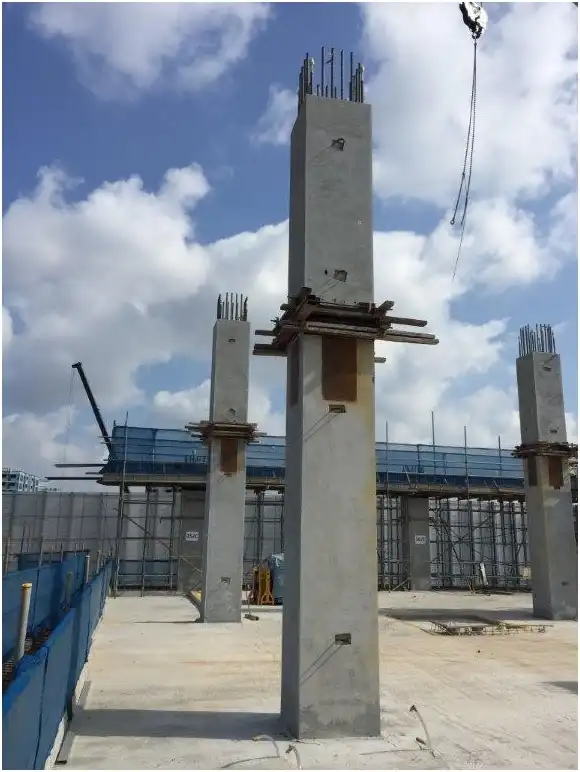A structural connection in the precast building is an assembly consisting of one or more interfaces and parts of the adjoining components, designed to resist the action of forces or moments. The purpose of connection in the precast building is to transmit forces between structural components, provide overall stability and prevent external leakages. In the complete precast structure or building, the structural connections between the components will form an essential part of the structural system. The structural response of the building will depend on the behavior and the characteristics of the connections.
Methods of structural connection in precast building
The Connections between precast elements can be achieved through
- Bolting
- Welding
- Grouting
The Method of Connection largely depends upon type of structure, seismic zone, availability of materials & hardware and skill set of site operatives.
Types of structural connection used in precast building
There are different types of structural connections used for various components of the precast structure.
- Column to foundation connection
- Wall panel to foundation connection
- Beam to column connection
- Column to column connection
- Floor to beam connection
- Wall to wall panel connection
- Column to column connection
- Beam to slab connection
- Stairs to wall connection
Column to foundation connection

For this kind of connection, you have to consider what kind of an impact the column connection can make on your overall building process. There are four kinds of the column to foundation connections.
Socketed connection- This will provide a fixed base connection to the precast column which is best suited for low-rise precast buildings. The cantilever action of the column provides lateral stability for the building thus reducing the amount of horizontal and vertical bracing required. In this connection, the overturning moments in the column will be resisted through proper embedment of the column in the concrete socket.
Bolted or base plate connection- The bolted connection between a column and a footing is designed to resist tension, compression and shear. It will be best to use a template for setting anchor bolts and for punching holes in the base plate to ensure proper fit in the field. It is a good practice to set the base plate overall dimensions slightly less then column dimensions to ensure prepper placement.
Mechanical splice connections- It is a moment connection to resist overturning moments. These types of connections are used in moment resisting column splices, cantilever, columns and wall panels. It is specifically used where columns that are part of the column-beam framing system that needs to be fixed at the bottom.
Grouted connections- This type of connection can be treated on par with the in-situ connections since the bedding joint and grouting sleeves are filled with grout. In this connection, dowel bars can be projected from the base or downward from the column.
Wall panel to foundation connection

These types of connections are used to tie the load-bearing walls to the foundation. Any connection joining a wall panel to a foundation wall or a continuous footing should provide a means of leveling and aligning the panel. The attachment method also should be capable of accepting the base shear in any direction. The capacities of these connections are the embed edge distances and other design assumptions that should satisfy production and design standards.
The connection is not tolerance sensitive. The embed plate and recessed pocket plate need to be properly sized to accommodate the loose angle and the associated welds. Perimeter bars exist as confinement in the precast concrete final. Connections centerline is a minimum of 60 mm from the edge of the precast concrete panel and the edge of the foundation.
Beam to column connection

Beam-to-column connections provide moment-resistant connections between beams and columns at the corners of frames or a moment resisting connection to elongate beams. The connection configuration and response including strength, rotational stiffness and ductility affect buildings in several ways for this dry and wet connections are possible in the beam to column connection.
In the case of the dry connection between beam and column, they can be widely classified into two types. Type one is the cone in which the vertical member is continuous and type two in which the vertical member is discontinuous. Type one can be further classified into hidden connections and visible and visible connections. Type two can be further classified into beam-ends resting on top of columns and continuous beams anchored at the head of the beams.
Column to column connection

Column to column connection’s primary function is to keep panels from bowing and/ or to transfer vertical shear force between panels. The connection is durable against corrosion due to the coverage for grout over the connection. This type connection involves the use of splice connection and anchor bolts.
Splice connection is used for both interior and exterior column to column connection and can be designed to emulate the characteristics of monolithic cast-in-place concrete. This connection is used when the actual column length is restricted due to production and handling restraints. A splice connection is also used to accommodate future expansions. This allows for uniformity connections.
Anchor bolt connections can be used in multi-story buildings. The base plate design is consistent with a standard column base plate connection. The pockets and base plate must be properly grouted. The anchor bolt material should be specified. The connection shear capacity is based on the shear friction and required the use of ductile anchor bolts capable of yielding and maintaining a clamping force. The material properties of the anchor bolt should be verified by the designer if the shear capacities are required.
Conclusion
In precast structural connection design, the key variables are strength, volume changes, ductility, durability including fire and corrosion, simplicity in production, installation and maintenance and loading conditions.
Image source – Splikesleeve.com, ConcretePrecastPlantTechnology.com, Cretematic.com, momentsolution.com


